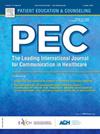Exploring empathy and patient-centered communication behaviors of third-year medical students during a clinical skills examination
IF 2.9
2区 医学
Q2 PUBLIC, ENVIRONMENTAL & OCCUPATIONAL HEALTH
引用次数: 0
Abstract
A previous study of third-year medical students’ empathy during a clinical skills assessment found that SPs rated female students higher than males, and male Black/African-Americans received the lowest empathy scores. Our objective was to analyze students’ patient-centered communication behaviors (PCCBs) to better understand those reported gender and racial/ethnic differences in empathy scores.
Methods
We examined 63 videos from the parent study, using discourse and content analysis to identify PCCBs during standardized patient (SP) encounters. Then, we determined which PCCBs significantly correlated with SP empathy ratings. Finally, we examined whether those significant PCCBs differed across third-year medical students' gender and race/ethnicity.
Results
We identified 18 PCCBs, six of which significantly correlated with SP empathy ratings. Generally, women tended to use patient-centered communication than men, while Black/African American men used less than Asian/Pacific Islander or white men.
Conclusion
In this exploratory, multiple methods study, we analyzed student discourse to better understand the reported gender and racial/ethnic differences in SP empathy scores. We found suggestions of gender and racial differences in behaviors related to patient-centered communication that need to be confirmed in larger, better-powered studies.
Practice Implications
If our findings are corroborated, understanding gender and race/ethnicity differences in PCCBs may help medical educators teach students patient-centered communication (PCC) in a more diverse, culturally situated way. Beneficial actions would include developing faculty to teach PCC with a multi-cultural emphasis and recruiting more minority faculty in our medical schools to model effective communication and empathy skills.
In addition, the PCCBs we identified through discourse analysis in this study can provide educators with a tool for teaching doctor-patient communication. Educators can review students' video encounters to provide specific and actionable feedback to promote PCC and empathy.
医三学生临床技能考试共情与以病人为中心的沟通行为探讨
之前的一项关于三年级医学生在临床技能评估中的同理心的研究发现,sp对女学生的评价高于男学生,而黑人/非裔美国男性的同理心得分最低。我们的目的是分析学生以病人为中心的沟通行为(PCCBs),以更好地理解这些共情得分的性别和种族差异。方法我们检查了来自家长研究的63个视频,使用话语和内容分析来识别标准化患者(SP)就诊过程中的pcbs。然后,我们确定哪些pccb与SP共情评分显著相关。最后,我们检验了这些显著的PCCBs是否在三年级医学生的性别和种族/民族之间存在差异。结果共鉴定出18个pccb,其中6个与SP共情评分显著相关。一般来说,女性比男性更倾向于使用以病人为中心的沟通,而黑人/非裔美国人比亚洲/太平洋岛民或白人男性使用较少。结论在这项探索性的、多方法的研究中,我们分析了学生话语,以更好地理解SP共情得分的性别和种族差异。我们发现,在以病人为中心的沟通行为中存在性别和种族差异,这需要在更大规模、更有力的研究中得到证实。实践意义如果我们的研究结果得到证实,了解PCC中的性别和种族/民族差异可能有助于医学教育者以更多样化的文化情境方式教授学生以患者为中心的沟通(PCC)。有益的行动包括培养教师,以多文化为重点教授PCC,并在我们的医学院招募更多的少数民族教师,以培养有效的沟通和同理心技能。此外,本研究透过语篇分析所发现的PCCBs,可为教育工作者提供教授医患沟通的工具。教育工作者可以回顾学生的视频相遇,提供具体和可操作的反馈,以促进PCC和同理心。
本文章由计算机程序翻译,如有差异,请以英文原文为准。
求助全文
约1分钟内获得全文
求助全文
来源期刊

Patient Education and Counseling
医学-公共卫生、环境卫生与职业卫生
CiteScore
5.60
自引率
11.40%
发文量
384
审稿时长
46 days
期刊介绍:
Patient Education and Counseling is an interdisciplinary, international journal for patient education and health promotion researchers, managers and clinicians. The journal seeks to explore and elucidate the educational, counseling and communication models in health care. Its aim is to provide a forum for fundamental as well as applied research, and to promote the study of organizational issues involved with the delivery of patient education, counseling, health promotion services and training models in improving communication between providers and patients.
 求助内容:
求助内容: 应助结果提醒方式:
应助结果提醒方式:


